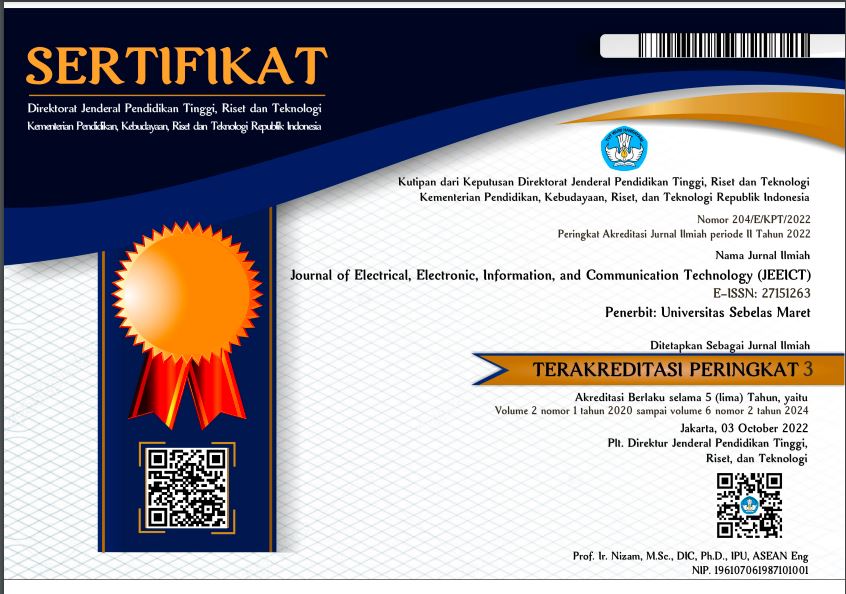MQTT Protocol-Based ESP-32 Smarthome with Multi-sensor Recognition
Abstract
Full Text:
PDFReferences
Dirjen Gatrik “STATISTIK KETENAGALISTRIKAN TAHUN 2022”, 2023 [Online]. Available: https://gatrik.esdm.go.id. Accessed on: Dec.31, 2023
A. D. Fakhrudin, N. F. A. Hakim, and A. H. S. Budi, “Implementasi Protokol TCP dan UDP pada Sistem Monitoring dan Otomasi Rumah Jamur Berorientasi WSN,” TELKA - Telekomunikasi Elektronika Komputasi dan Kontrol, vol. 9, no. 2, pp. 130–144, Nov. 2023.
A. Natarajan, V. Krishnasamy, and M. Singh, “Occupancy detection and localization strategies for demand modulated appliance control in Internet of Things enabled home energy management system,” Renewable and Sustainable Energy Reviews, vol. 167, p. 112731, Oct. 2022.
S. Maghrisya, A. M. Ridwan, M. R. Effendi, N. F. Arief Hakim, R. P. Sari and R. Ramdani, "Prototype of Glucose Meter with Non-Invasive Method Based on IoT," 2023 9th International Conference on Wireless and Telematics (ICWT), Solo, Indonesia, 2023, pp. 1-5.
J. A. Hassan and B. H. Jasim, “Design and implementation of internet of things-based electrical monitoring system,” Bulletin of Electrical Engineering and Informatics, vol. 10, no. 6, pp. 3052–3063, Dec. 2021.
S. Garg, A. Yadav, S. Jamloki, A. Sadana, and K. Tharani, “IoT based home automation,” Journal of Information and Optimization Sciences, vol. 41, no. 1, pp. 261–271, Jan. 2020.
R. Damayanti and M. Mabe Parenreng, "Rancang Bangun Smart Home Berbasis Internet of Things," JASENS, vol. 1, no. 2, pp. 5-09, 2020.
W. W. Anggoro and I. R. Widiasari, "Perancangan dan Penerapan Kendali Lampu Ruangan Berbasis IoT (Internet of Things) Android," Jurnal Teknik Informatika dan Sistem Informasi, vol. 8, no. 3, pp. 1596-1606, 2021.
S. R. Hidayati and I. Nirmala, "Smart Lamp: Kendali dan Monitor lampu Berbasis Internet of Things," JUPITER, vol. 14, no. 2, pp. 507-515, 2022.
D. Susilo, C. Sari and G. w. Krisna, "Sistem Kendali Lampu pada Smart Home Berbasis IoT (Internet of Things)," ELECTRA: Electrical Engineering Articles, vol. 2, no. 1, pp. 23-30, 2021.
F. Z. Rachman, "SMART HOME BERBASIS IOT," SNITT, pp. 369-374, 2017.
Md. W. Rahman et al., “The architectural design of smart blind assistant using IoT with deep learning paradigm,” Internet of Things, vol. 13, p. 100344, Mar. 2021.
N. A. Zen, S. Indriyanto, I. Permatasari, J. Sasmita, and L. Yuliantini, “Preliminary study of using KY-038 sensor based on Arduino Uno and labview to determine the pulse rate,” Jurnal Fisika dan Aplikasinya, vol. 16, no. 2, p. 87, 2020.
Y. A. Ahmad, T. Surya Gunawan, H. Mansor, B. A. Hamida, A. Fikri Hishamudin and F. Arifin, "On the Evaluation of DHT22 Temperature Sensor for IoT Application," 2021 8th International Conference on Computer and Communication Engineering (ICCCE), Kuala Lumpur, Malaysia, 2021.
Zulfahmi Syahputa, M. Z. “Testing Real-Time Applications on Windows 10 IOT Using the Nyquist Theory”. Journal of Physics , 012066, 2019.
S. Wagle, ‘‘Semantic data extraction over MQTT for IoTcentric wireless sensor networks,’’ in Proc. Int. Conf. Internet Things Appl. (IOTA), pp. 227–232, 2016.
Mulyono, S., Qomaruddin, M., & Syaiful Anwar, M., “Penggunaan Node-RED pada Sistem Monitoring dan Kontrol Green House berbasis Protokol MQTT” Jurnal Transistor Elektro Dan Informatika (TRANSISTOR EI), vol. 3 no.1, pp. 31–44, 2018.
R. B. Ghoderao, S. Raosaheb Balwe, P. S. Chobe, D. B. Pardeshi and P. William, "Smart Charging Station for Electric Vehicle with Different Topologies," 2022 6th International Conference on Intelligent Computing and Control Systems (ICICCS), Madurai, India, 2022, pp. 243-246.
Permatasari elza Fitria dwi, Putrada aji gautama, Abdurohman Maman, “ Analisis perbandingan performansi MQTT dan HTTP pada platform Node-Red” e-proceeding of engineering, vol. 6 no.2, pp 8559-8569, 2019.
K. Okokpujie, D. Jacinth, G. A. James, I. P. Okokpujie and A. A. Vincent, "An IoT-Based Multimodal Real-Time Home Control System for the Physically Challenged: Design and Implementation," Information Dynamics and Applications, vol. 2, no. 2, pp. 90-100, 2023.
M. Li et al., “Smart home: Architecture, technologies and systems,” Procedia Computer Science, vol. 131, pp. 393–400, 2018.
Refbacks
- There are currently no refbacks.







